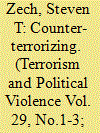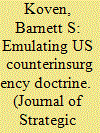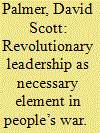| Srl | Item |
| 1 |
ID:
152958


|
|
|
|
|
| Summary/Abstract |
This issue of Small Wars and Insurgencies focuses on the continuing importance of Maoist and post-Maoist concepts of people’s war. It has assembled a collection of papers that addresses various examples from around the world, with an emphasis on South America, where the premier illustration, that of Colombia’s FARC, was Marxist-Leninist but not Maoist, yet embraced the form and strategy of people’s war in a bid which at one point had the state in a critical situation. The collection comes in the wake of previous papers published in this journal on politically Maoist insurgent movements in South Asia, notably Mika Kerttuenen’s study of Maoist insurgents in Nepal and Prem Mahadevan’s survey of Maoist insurgencies in India and their links to organized crime (Kerttunen, “A Transformed Insurgency,” 78–118; Mahadevan, “The Maoist Insurgency in India,” 203–20). The papers confirm that people’s war remains an important analytical framework in the study of small wars and insurgencies, for some even a ‘model’ through which to understand distinct types of insurgent movements and their strategies.
|
|
|
|
|
|
|
|
|
|
|
|
|
|
|
|
| 2 |
ID:
152871


|
|
|
|
|
| Summary/Abstract |
In this article I identify and evaluate numerous reasons why torture became common practice during the state counterterrorism campaign in Peru between 1980 and 2000, despite international and domestic legal obligations to protect human rights. I describe common structural conditions, organizational factors, and individual-level explanations often associated with torture practices. I then identify seven logics and motivations behind torture use in counterterrorism campaigns. I describe and analyze actual torture use in Peru using quantitative incident-level data, and I provide descriptive statistics concerning variation in the frequency and methods of torture. Finally, I examine specific incidents of torture to illustrate and assess the different logics and motivations for torture. I draw heavily from testimonies collected by Peru's Truth and Reconciliation Commission. I also rely on personal interviews carried out during fieldwork in the Junín and Ayacucho regions of Peru. I find that aggregate torture incidents generally coincide with political developments and shifts in violence levels and that the various state security forces used torture differently. A review of testimonies regarding specific incidents of torture suggests that multiple logics motivate state security forces, even for a single incident of torture, complicating academic efforts to formulate a parsimonious causal explanation.
|
|
|
|
|
|
|
|
|
|
|
|
|
|
|
|
| 3 |
ID:
148223


|
|
|
|
|
| Summary/Abstract |
Recent US advances in counterinsurgency doctrine have been adopted by developing country armed forces. Nevertheless, no systematic study has examined the barriers they face to implementing highly involved counterinsurgency strategy. Tracing the evolution of Peruvian doctrine demonstrates that Peru was able to quickly improve the unity of effort, intelligence capacity, and military basing to meet the demands of a population-centric hearts-and-minds approach to counterinsurgency. Nevertheless, the limited tactical initiative and flexibility of Peruvian forces remains a challenge. The Peruvian experience is instructive for other militaries undergoing similar transitions. However, given the diversity of insurgent conflicts, this doctrine is not universally appropriate.
|
|
|
|
|
|
|
|
|
|
|
|
|
|
|
|
| 4 |
ID:
129511


|
|
|
| 5 |
ID:
152959


|
|
|
|
|
| Summary/Abstract |
Though it is well understood that all internal upheaval within a polity is a consequence of agency interacting with structure, the importance of the former has perhaps become too pushed to the rear. In reality, as demonstrated by the case of Sendero Luminoso (Shining Path) in Peru, even cases which seem most determined by structural factors, in practice remain problematic, absent necessary revolutionary leadership. This leadership in turn, can make mistakes just as it guides successes.
|
|
|
|
|
|
|
|
|
|
|
|
|
|
|
|
| 6 |
ID:
173828


|
|
|
|
|
| Summary/Abstract |
This article examines the strategies employed – or not employed – in the Peruvian counterinsurgency campaign against the Sendero Luminoso insurgent group. Using Carl von Clausewitz’s and Colin Gray’s strategic theories as a lens through which to analyze the conflict, the aim here is to show what role strategy played in the eventual defeat of this insurgency and what obstacles the Peruvian state and its armed forces faced in enacting good strategy. Specifically, the utilization of the ‘strategy bridge’ concept is investigated. For a large part of this conflict, the strategy bridge linking the civil authorities with the military and its activities was missing. Once there emerged a clear understanding of the importance of ends, ways and means working in harmony could an effective counterinsurgency campaign flourish.
|
|
|
|
|
|
|
|
|
|
|
|
|
|
|
|
| 7 |
ID:
129033


|
|
|